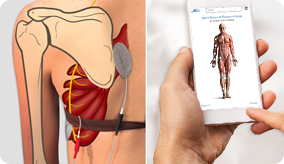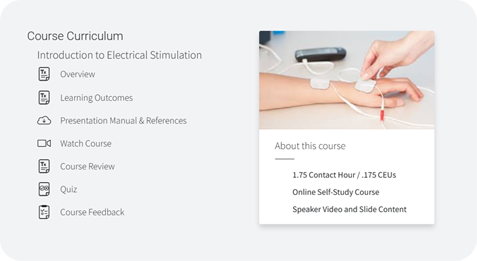
Educational Resources
Axelgaard is proud to offer free educational resources via our video series and our interactive visual guide. The guide is viewable both on desktop and mobile and all of our videos can be watched online or downloaded for offline viewing.
Interactive NMES Electrode Placement Guide

In collaboration with Dr. Lucinda Baker of the University of Southern California’s Division of Biokinesiology and Physical Therapy, Axelgaard’s Electrode Placement Guide is a free, interactive resource for electrode placement. This informative guide features 41 instructional videos, illustration-enhanced electrode placement photos, and relevant information on muscular and neurological anatomy.
OT Course on Electrical Stimulation

In collaboration with Salia Rehab, this course guides learners through the general considerations and specific applications and treatment techniques for electrotherapeutic interventions. Learners will review best practices for safe, effective, and efficient application of electrical stimulation modality treatments to a variety of clinical presentations. In addition, concepts associated with use of electrical stimulation in occupational performance will also be reviewed.
The online class is intended for medical professionals (e.g. OT/OTA, PT/PTA, Physicians, etc.) directly related to the rehabilitation of a patient or client.
NMES Electrode Placement Videos
We are pleased to sponsor the Electrode Placement and Functional Movement series presented by Dr. Lucinda Baker, Associate Professor at USC Division of Biokinesiology and Physical Therapy. These videos provide comprehensive information on the preparation and use of electrodes for effective neurostimulation treatment. All electrodes used in the video presentations are PALS® neurostimulation electrodes.
Individual chapters and the full DVD ISO file are available for free download alongside each video for offline viewing.
Chapter 38
Download Chapter
Download full DVD ISO
HZ: 35
Waveform: Symmetric
Stimulation Grade: 2/5
Electrode placement for plantar flexion stimulation. The popliteal fossa is marked, and the lateral malleolus is visible. Two large electrodes are used, along with a symmetric biphasic waveform, to allow activation of the whole gastroc soleus complex. The proximal electrode is placed over the origins of both the medial and the lateral gastroc.
The distal electrode is placed over the soleus, where it is exposed. During stimulation active plantar flexion occurs, but because this subject is not weight bearing it would have to be graded two out of five.